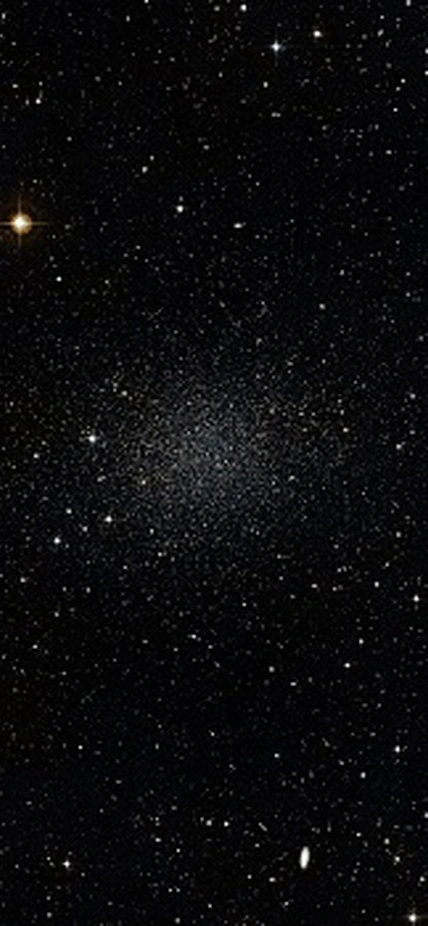Pasadena, CA— A Carnegie-based search of nearby galaxies for their oldest stars has uncovered two stars in the Sculptor dwarf galaxy that were born shortly after the galaxy formed, approximately 13 billion years ago. The unusual chemical content of the stars may have originated in a single supernova explosion from the first generation of Sculptor stars. The team, which includes Carnegie’s Josh Simon, Ian Thompson, and Stephen Shectman, published their work in The Astrophysical Journal.
The Sculptor dwarf is a small galaxy that orbits around our own Milky Way, just as the Moon orbits around the Earth. Large galaxies like the Milky Way can contain several hundred billion stars, but Sculptor is home to just a few million. Because Sculptor’s stars are all located the same distance away from us, their ages can be determined by studying the pattern of their colors and brightnesses. This technique tells astronomers that Sculptor, like many dwarf galaxies, stopped evolving long ago. While the Milky Way has been forming stars throughout the universe’s 14 billion year existence, Sculptor’s youngest stars are 7 billion years old. Dwarf galaxies thus provide scientists an opportunity to see what galaxies looked like in the early epochs of the universe.
Stars in all galaxies are born out of collapsing clouds of dust and gas. Only a few million years after they begin burning, the most-massive of these stars explode in titanic blasts called supernovae. These explosions seed the surrounding gas with the elements that were manufactured by the stars during their lifetimes. Those elements are then incorporated into the formation of the next generation of stars. Generally this process is cyclical, with each generation of stars contributing more elements to the raw material from which the next set of stars will be formed.
Astronomers hoping to learn about the first stages of galaxy formation after the Big Bang can use the chemical composition of stars to help them unravel the histories of our own and nearby galaxies. Elements heavier than hydrogen, helium, and lithium can only be produced by stars. The more stars a galaxy forms, the more enriched in heavy elements it becomes.
Thus, young stars contain larger amounts of heavy elements produced by dozens or hundreds of supernovae, while the oldest stars have a very simple chemical makeup with few of the heavy elements. Typically, stars are characterized by how much iron they contain, because iron is a relatively common element and is almost always the easiest for astronomers to detect.
The team—also including Heather Jacobson and Anna Frebel of the Massachusetts Institute of Technology, as well as former Carnegie postdoc Josh Adams—studied five stars in Sculptor, measuring the abundance of 15 elements in each one. The two most primitive stars have less than half as much magnesium and calcium as would be expected based on their iron content and just 10 percent as much silicon as similar stars in other galaxies.
“The only way to explain the shortage of magnesium, calcium, and silicon in these stars is if their heavy elements were made by fewer than four supernovae, and those supernovae need to have been a rare kind of explosion,” explained Simon.
The astronomers concluded that these two primitive stars were probably formed from a gas cloud that had been seeded with heavy elements made by just one previously exploded star. This parent star is thought to be one of the very first stars ever formed in Sculptor.
“Most likely, we are seeing the leftover traces of just a single supernova,” added Jacobson.
“These stars are giving us an unprecedented view of the earliest history of another galaxy,” Frebel said.
Caption: The Sculptor dwarf galaxy composed from data from the Digitized Sky Survey 2, courtesy of ESO/Digitized Sky Survey 2.
_________________
This work was supported in part by the National Science Foundation. It made use of NASA’s Astrophysics Data System Bibliographic services. Data were gathered with the 6.5-meter Magellan telescopes at Carnegie’s Las Campanas Observatory in the Atacama desert of Chile.
